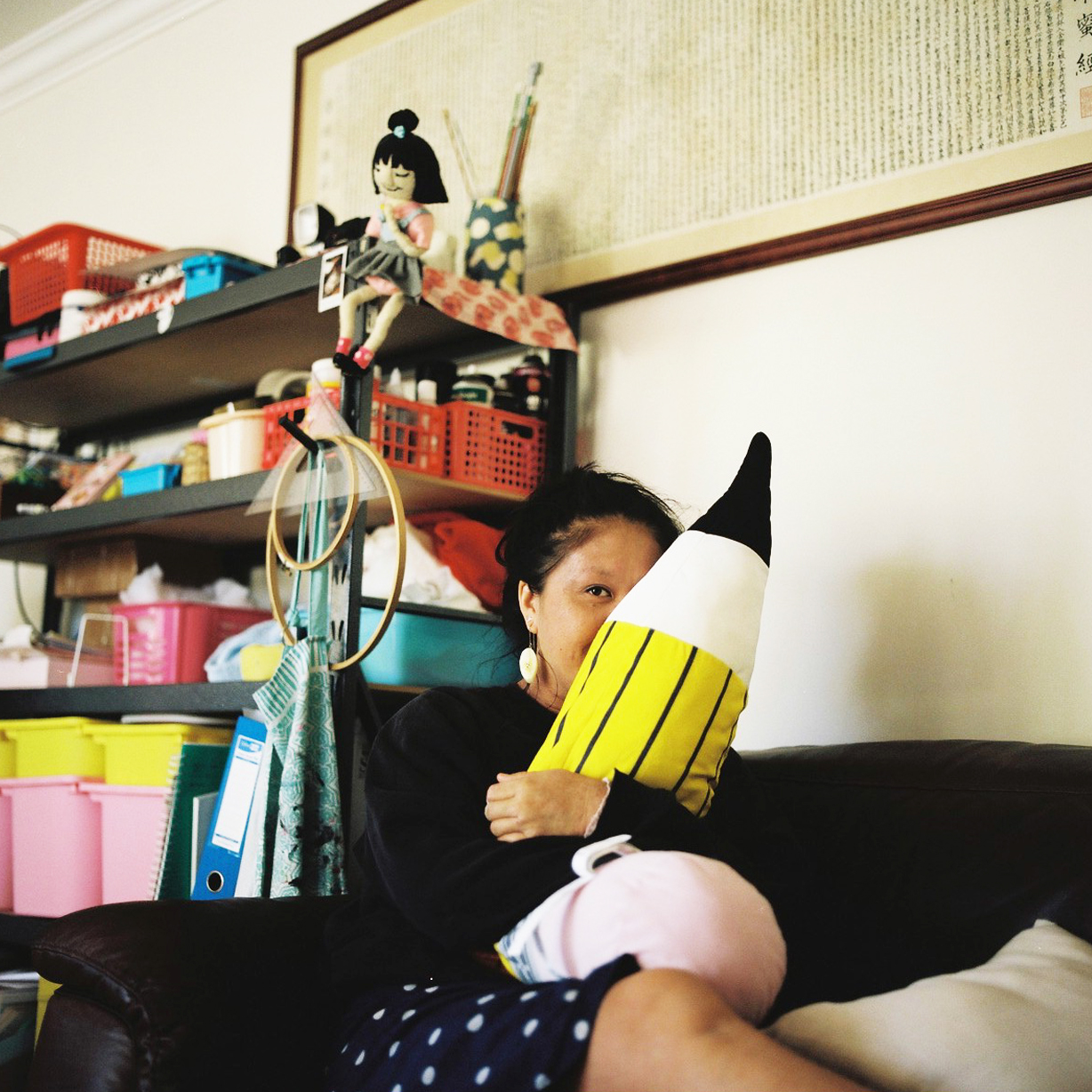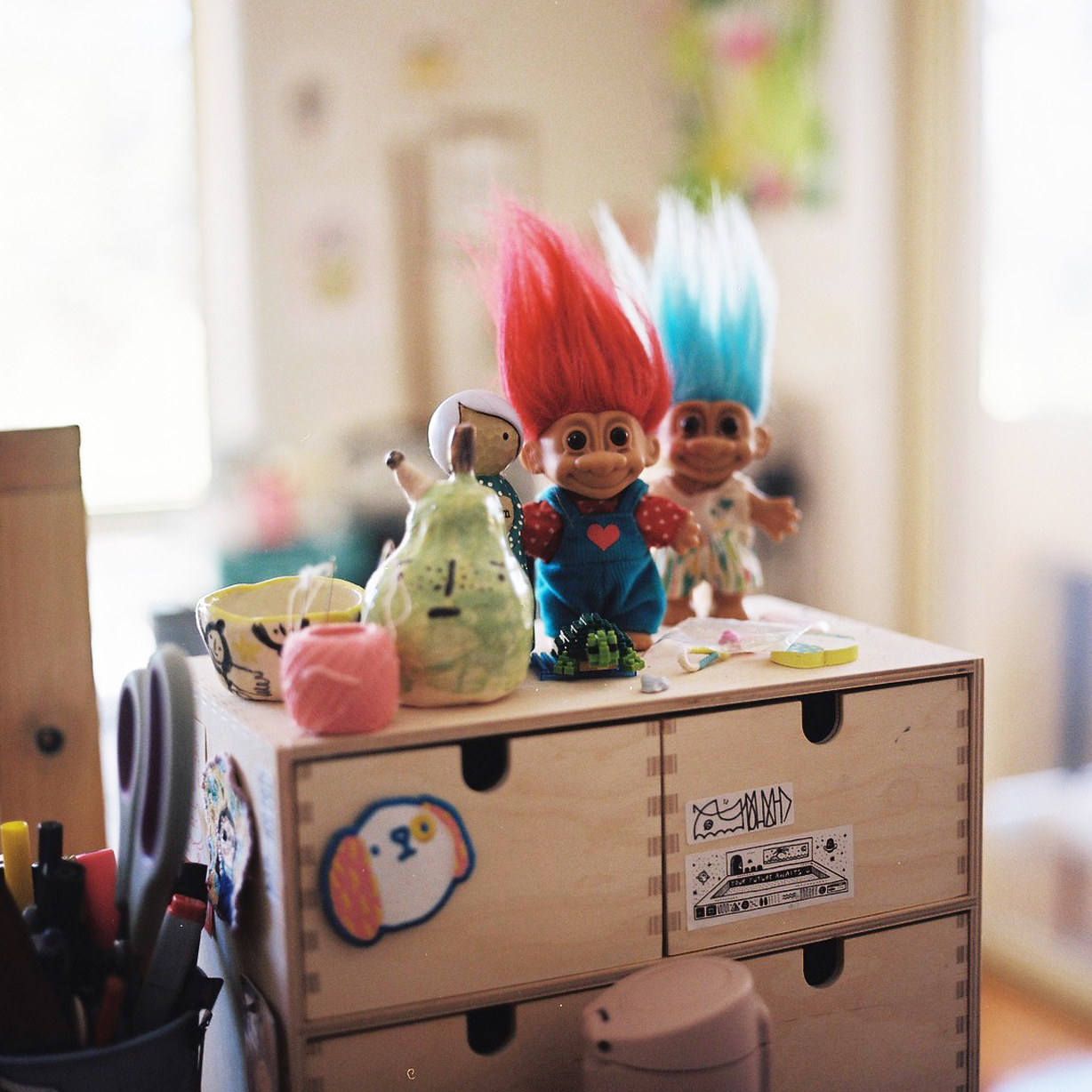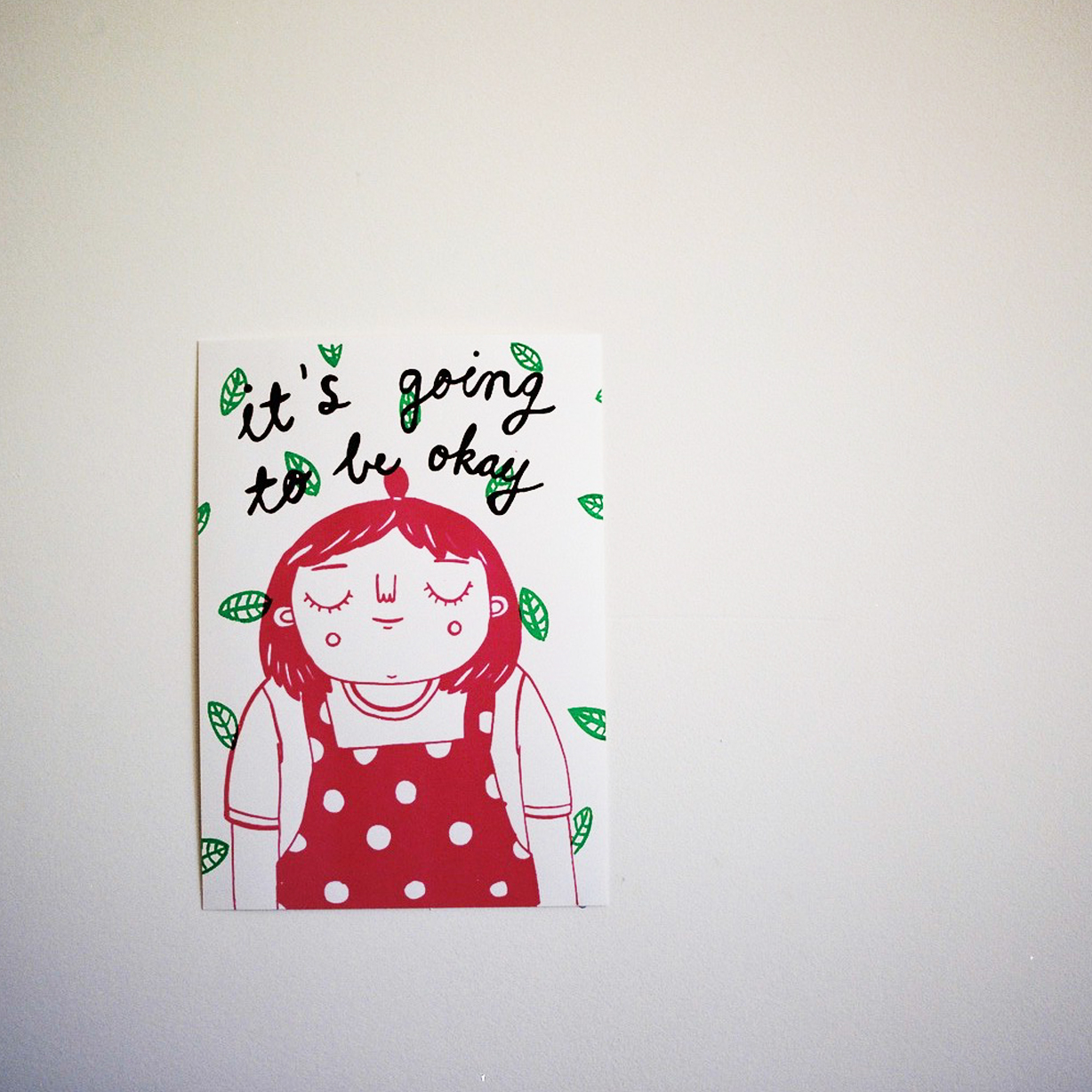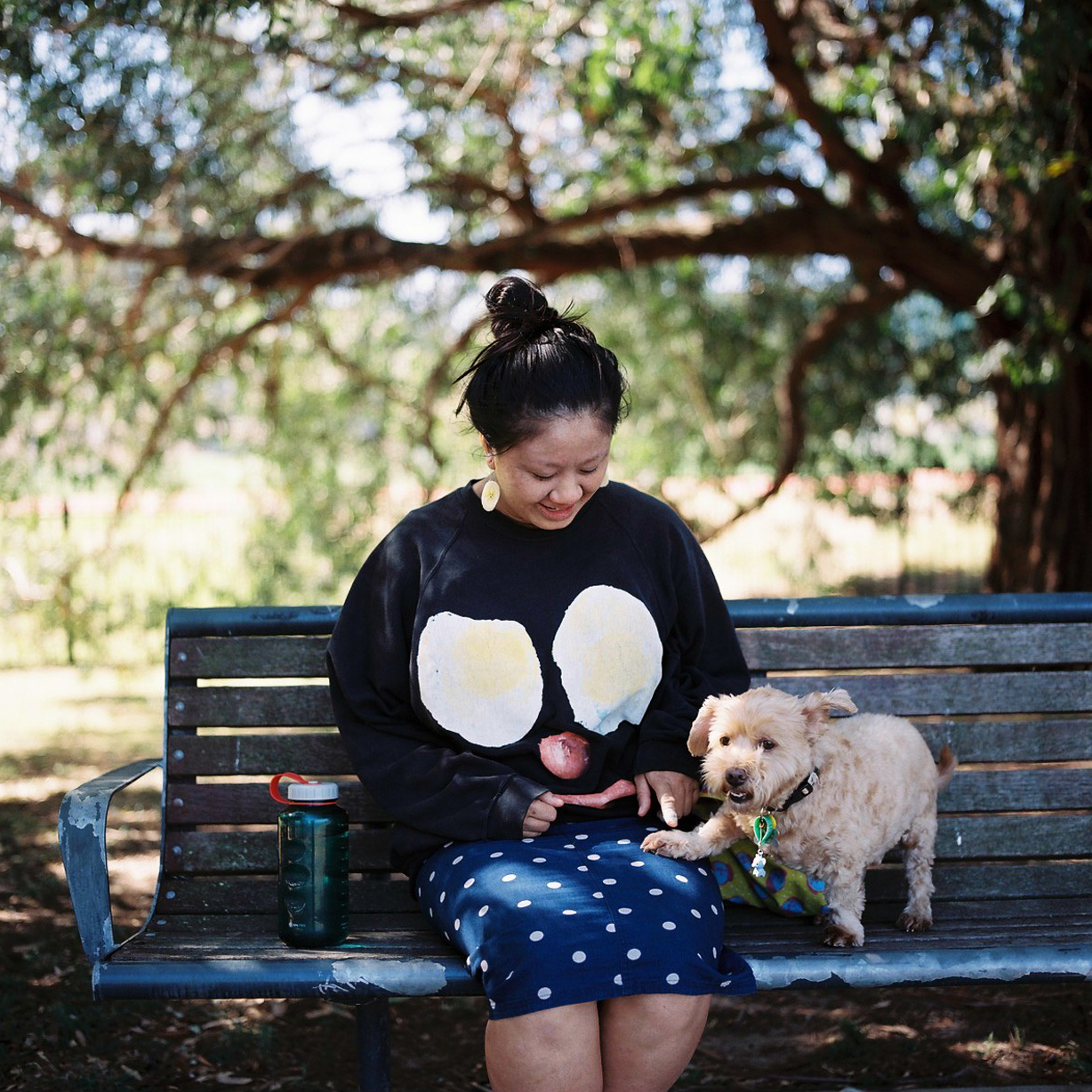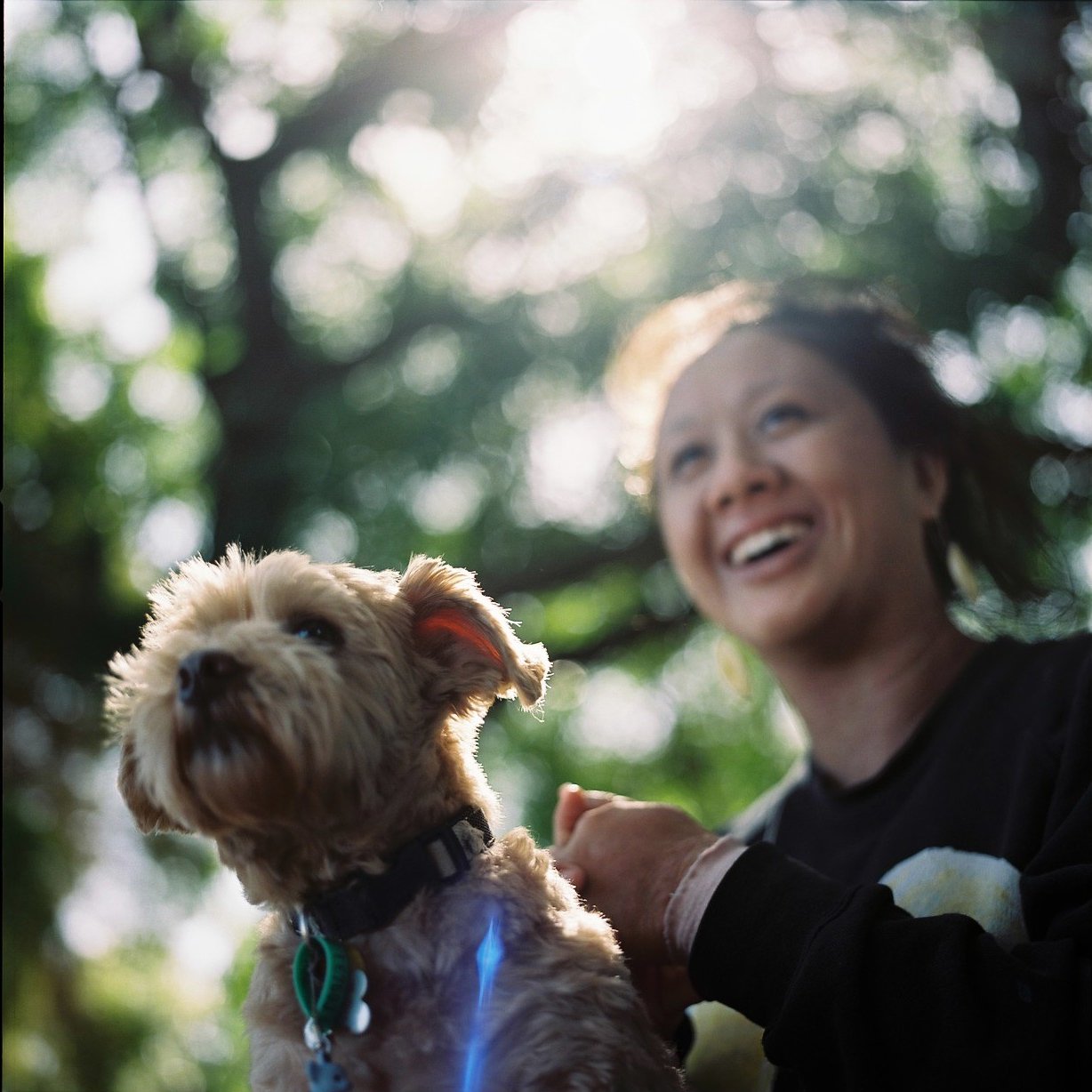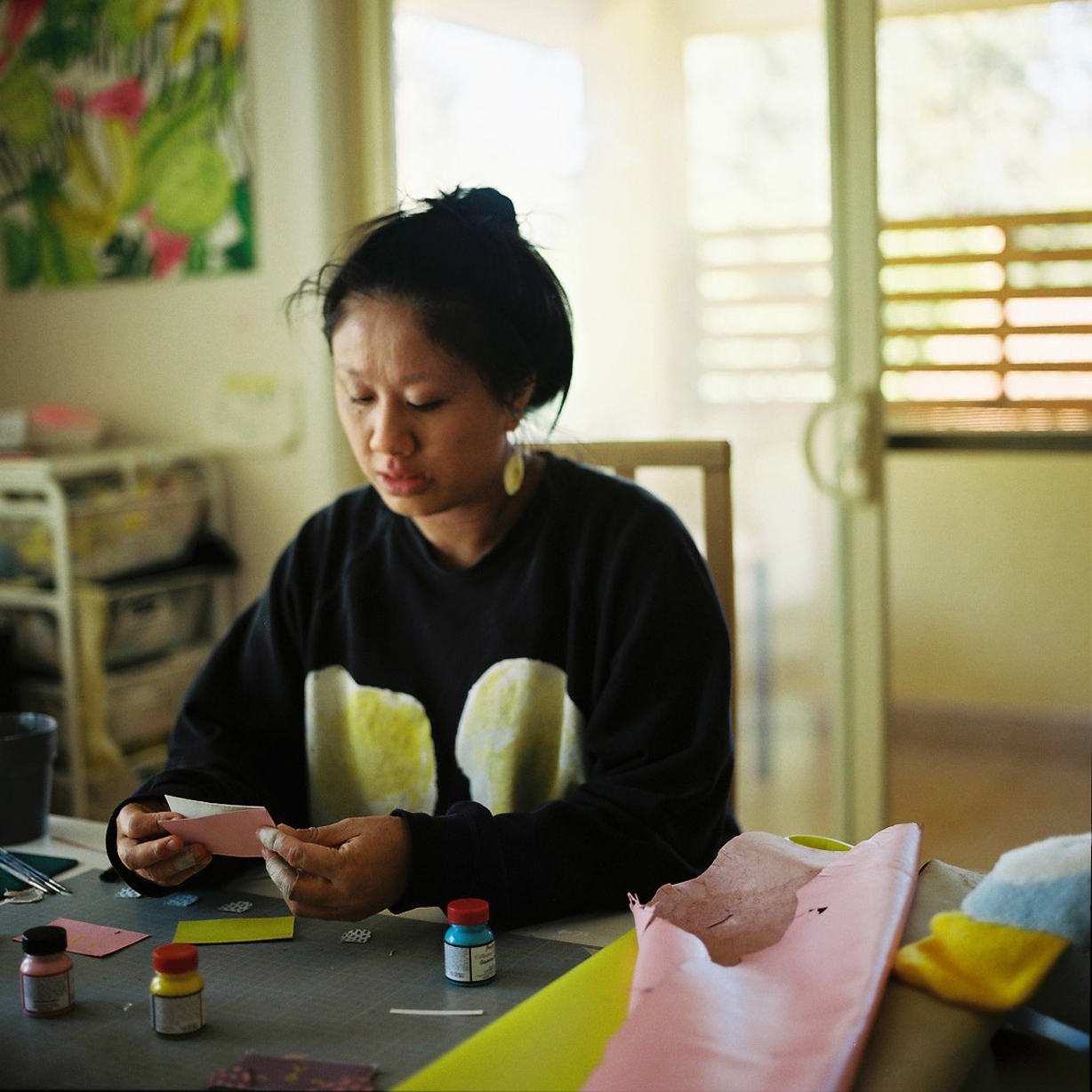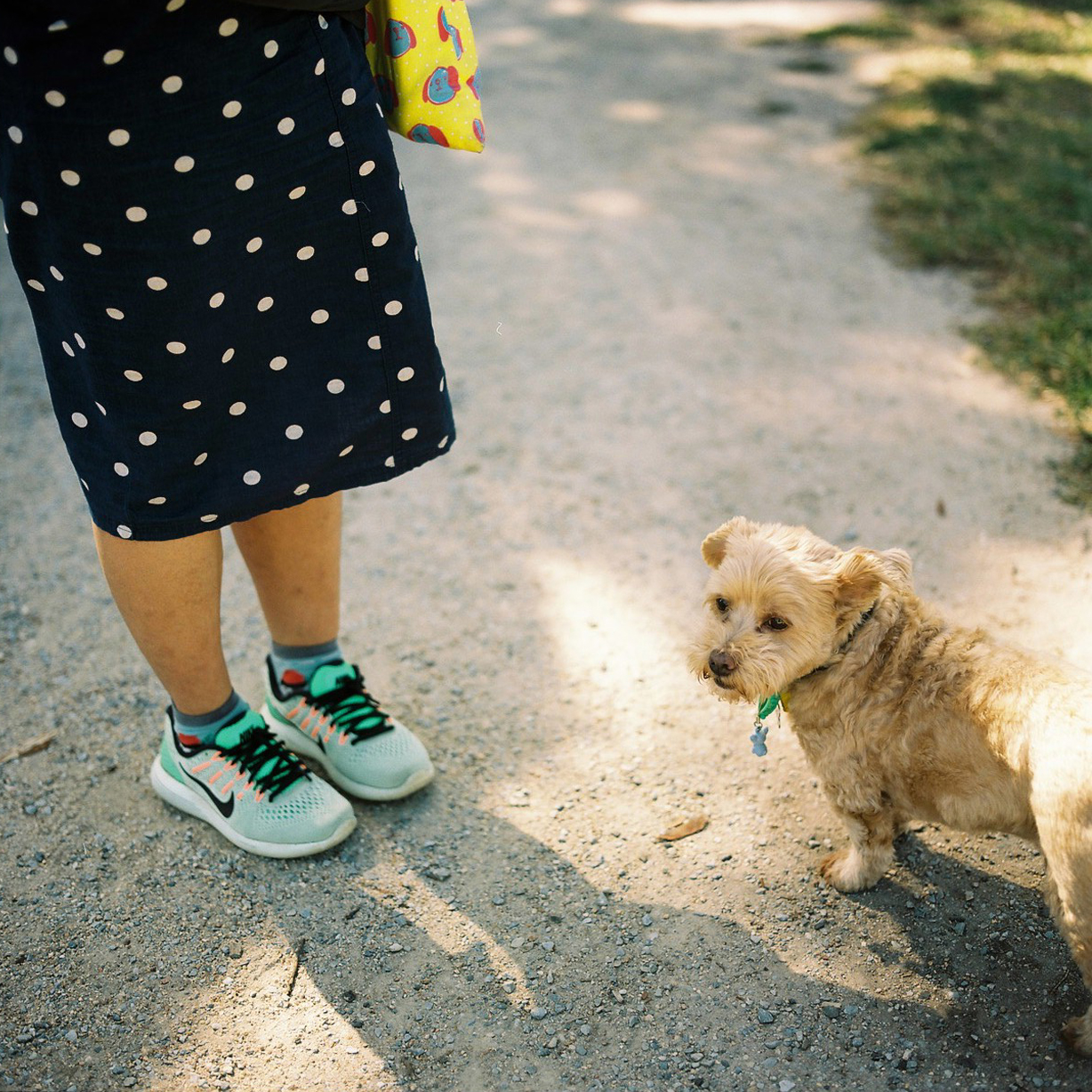Interview #21 — Peggy Chin
by Leah Jing McIntosh
Peggy Chin is a Melbourne-based designer, maker and screen printer. She runs a small business driven by her creative practice in her home studio, and she is completing her Bachelor of Arts in Textiles Design at RMIT. Her works spans across a range of materials, such as wood, textiles and paper, but centres itself around a love for her dog, Booster. Peggy can be most accurately described as a purveyor of pupper paraphernalia.
Can you talk to us about your creative trajectory?
In 2013 I enrolled in a Bachelor of Communication Design at Monash, but two weeks later I dropped out. That degree wasn’t clicking with me—it just didn’t feel right. Instead, I took a gap year. During that year, I struggled with depression quite a bit; I had no idea what I was going to do with my life. I was so lost, but I’ve always known I wanted to pursue some form of art.
To fight off the depression, I started assigning myself small projects—upholstering an office chair with some cute fabric, making tote bags, printing fabrics—really low-key stuff. I fell in love with what I was doing, but I still had no idea where it would lead me. I came across a BA in Textiles Design at RMIT, and applied. I was so nervous because if I didn’t get in I had no clue what I was going to do, but B L E S S B L E S S AND B L E S S—I got in!
So I’ve been completing my course since 2014. I’m absolutely in love with my degree—I’ve learnt so much, and I’m so happy I get to do what I love. But—it’s a lot of hard work. There’s a lot of work that goes behind designing a pretty pattern. You don’t have a social life and every waking hour your brain is preoccupied with your work, and you just don’t have time to do anything other than your degree. It’s a labour of love.
In saying that, I’m actually a part time student now. During the second half of the first year of my degree I started getting sick. I am now chronically ill and that too has changed my life. I guess that’s been the catalyst for my work. It’s one of the hardest things I’ve had to deal with.
How did you become chronically ill?
My illness is an iatrogenic condition, it’s fully preventable; it’s caused by the over prescription of topical steroids by doctors and dermatologists. It’s called Topical Steroid Withdrawal, otherwise known as Red Skin Syndrome. It’s hard to pinpoint when exactly it all began, as topical steroid addiction and withdrawal can often look like severe eczema.
Topical steroids are used to treat eczema patients. All of my life I’ve had eczema but it was always quite mild – I just had a few patches here and there. I’ve been using mild topical steroids all of my life too. My eczema became quite unpredictable when I was 18. So, in order to treat my worsening eczema I went to a doctor who prescribed me very strong topical steroids. He also put me on a few rounds of oral steroids, and also administered one anti-inflammatory injection. I think at this point I was already reliant on topical steroids—everything was just a temporary fix. I was seeking out ways to fix my skin, so I made an appointment with a dermatologist. At first, things were okay. I went through some UV light treatment in conjunction with “slathering” on potent topical steroids, as I felt necessary.
“Slathering” was what my “dermatologist” instructed me to do. She would prescribe me nine tubes of potent topical steroids and tell me to “slather” it all over. She was meant to be an expert.
It was the second semester of my first year of university. I had planned to go on exchange—I didn’t know where at that point, I was looking at Hong Kong, or maybe Scotland, or Parsons in the States. I had all of these things that I was looking forward to… all of these goals for all of my youth. I remember the afternoon I decided that I had to stop using topical steroids. I was eating pho in Box Hill with my mum and I told her that I needed to withdraw, but I wasn’t sure if I should do it now, or wait until I finished my first year of university.
I stopped using topical steroids on the 1st of October, 2014. In the beginning my symptoms were mild. In fact, I thought that my withdrawal period would be over within 3 months. It started off with a mild rash which eventually became widespread. I was as red as a tomato. And also as plump as one too! Some of the symptoms I displayed were: insomnia, nerve pain, hair loss, loss of temperature control, skin shedding in huge amounts, elephant skin, fatigue and temporary blurred eyesight. It’s hard for me to replay everything that I had to go through. I was housebound for six months. The nerve pain was the worst… it’s the sort of pain that makes you cry out for your mum and dad in the middle of the night. I couldn’t even get up from the couch because I was so fucking tired because my body was working so hard to get me better.
Nowadays, things are okay. My skin is still problematic, but I’ve learnt to cope with it. It has weird pigmentation issues, it's very dry and I have elephant skin due to swelling. I’m swollen all over—especially in my extremities. For a long time I felt confined to long sleeves because I was so conscious of how gnarly my arms looked, but my arms have been free for a while now, thank goodness. I’m not really itchy, but more in a constant state of sunburn. I’m still losing a lot of hair but it’s growing back too. My eyebrows still haven’t grown back yet and it’s nearly been three years!
My skin will get better eventually—it goes through cycles—it starts off red and angry, and then it’ll shed for a while until it is “normal” again. And the cycle continues until it eventually becomes “normal” skin.
How has this experience shaped you?
My days are very different. I don’t just wake up and go anymore. I need to eat or else I feel deathly tired. I get tired easily. I have to rest more. I don’t really look at mirrors anymore. It’s no longer as simple as doing something because I want to do it. There’s a thought and consideration in regards to my physical wellbeing that goes into it.
I was thinking the other day about how much I miss the carefree, fun-loving Peggy but at the same time, I am a completely different person in both good and bad ways. I think I’m harder to please now, a bit sterner, I don’t laugh as easy. When people ask me to go out, I just think about how tired I’ll be at the end of the day. Do I have enough energy left in me to go the extra mile? I had never experienced anxiety or panic attacks… but now I am very familiar with them. There is a loss of freedom.
I also look at people differently. I’m more empathetic. Everyone has lived their own lives, dealt with their own shit, so who knows why they might be treating me in a particular way? Maybe you had an interaction with someone who was rude to you, or cut you off, or just treats you terribly—what do they have going on in their lives? Maybe as much as you, or maybe even more.
I’ve learnt not to care anymore. To not care if people look at me funny, or dart around my face as they speak to me. I’ve learnt not to care if a girl tells her boyfriend to look at my skin. You’ve got to live your life the way that you want, in spite of what everyone around you may say behind closed doors.
Has your art been altered by your illness?
Right now, my art is happier, brighter and much more colourful. I’m at a point in my life where I need to amplify and project my inner sunshine. I love making art that makes people happy. I love it when people walk by my stall at a market and they giggle and smile—even just for a minute of their day. We can’t take life too seriously.
In the beginning, when my chronic illness was more consuming—my work was the art that I needed. I needed to know that I’ll be okay. It was about positive affirmations that I needed, and others needed too. Things like, It’s okay, you’ll be fine, you can do this! That’s how I coped with my chronic illness.
You’ve got to remind yourself how lucky you are that you are alive every day. We often float by in life like we’re invincible. But in reality, you may die tomorrow or in ten years, or when you’re one hundred and ten. You just don’t know. And you’ve got to remind yourself of that day every day! I try to remind myself that even though I’m struggling, at least I’m not dead yet, so that’s good. It’s tough because I don’t wake up like I used to. I don’t go out and just go out. It’s not that simple anymore. But the good thing about my illness is that eventually it will get better.
It seems that sentimentality and existentialism are two themes that run through your work.
My existentialism is related to chronic illness. I’m always thinking about my future and my imminent death. Sentimentality is taking all of the lovely little things in life and romanticising them in my head. My old zines were usually soaked with sentimentality, either about a high school crush, or my one ex, or my dog – really just about my love for things, or people.
How do you navigate your identity as a Malaysian-Australian?
So my Dad is from Hulu Langat in Selangor, and Ma is from Paya Rumput in Melaka. My parents migrated to Australia a couple of years before I was born. I went back to Malaysia a month or so ago for the first time since becoming chronically ill. It was a big milestone, I’ve been looking forward to for a while. I used to head back every second year with my family, but I haven’t been able to because of my skin. My trip was really lovely, but also really hard. Before and during the trip, my skin flared up and was the worst it has been in a while. It’s almost like with everything that I did, and every new place that I went to, there was an undercurrent of anxiety and stress.
It was also really tough seeing my relatives again because a lot of them wanted to fix me; they wanted to give me Chinese medicine, pray for me, fight off the black magic with more magic, or send me to a specialist. This can be a very tiring interaction because it often comes from the assumption that my life is lesser because of my chronic illness. Despite all of the crap I’ve endured, I’m really happy with my life. I don’t need anyone to feel sorry for me. I don’t need to—or want to—be fixed. I’m tired, but hell, I’m happy.
I love going back to Malaysia because it is so familiar that it feels like home. In high school, I would tell one of my friends that I would be going back home (to Malaysia) and she would always say to me, quite angrily, “What do you mean your home? Australia is your home”.
I struggled to accept my “Asian-ness” when I was younger. I wouldn’t use chopsticks. I didn’t like Asian bowls or cute Asian things.
That is a theme that runs through a lot of our interviews.
I went to a predominantly Asian high school and live in a predominantly Asian suburb so I’ve never really felt like I’ve been a target of racism. I remember watching Home and Away when I was younger and Australia’s not like that at all! We aren’t just white people.
A lot of your art is based around your puppy, Booster, which I love. How did Booster come into your life?
So Mum had always said “No dogs, no pets”. I came home from work and heard news about a stray dog—and I love dogs, I’d always wanted one. We brought him to the vet to check his Microchip. The nurse gave the number a ring, and the owner said he had given the dog away to his friend. He really didn’t care. The vet took him to the RSPCA where he had a two week quarantine period, which allows owners to claim their dog before they’re put up for public adoption.
Giving Booster away to the RSPCA was heartbreaking. I remember walking out of the vet and just sobbing. Those two weeks when Booster was in quarantine were two of the hardest weeks ever. We had to take our whole family to the RSPCA to prove that the whole family was involved.
At the start, it was ‘no dog inside’. But then he made it inside and it was ‘no dog on the couch’. But then he made it on the couch and it was ‘no sleeping in the bed’—now he sleeps with us. It’s been a love story and I can’t imagine my life without him. He’s changed the family dynamic, everyone loves him so much—we bond over his cuteness! It’s so weird that dogs do that. They bring an immeasurable amount of joy to a home.
Do you have any upcoming projects that you’re working on?
I’m working on a new range of designs! I’m not sure where exactly they’re headed yet, but they are going to be cute. I always have ideas in my head and it’s just a matter of actually biting the bullet and making them come to life! I’m also trying to take things slow because I know I’ll be so busy next year with my last year of my degree.
Is there a facet of your field that you would like to see change?
Sustainability weighs on my mind quite heavily. Can I create sustainably? Can production be sustainable? Or is that not possible, as every thing that we make has a negative environmental impact on the earth? I’m studying textiles design, which is a part of the Textiles and Fashion industry. This is a terrible terrible industry, which is neither environmentally or socially sustainable.
Walk into H&M, Uniqlo, Target, Big W, Topshop, Kmart, and look at all of the hundreds upon thousands of clothes. Where are they made? Whose hands have made them? Where do you think they’ll go? All of those clothes are made to break down on you—planned obsolescence. And not only are they made from sub-par material, they are also made by women and children in developing countries who are underpaid and are often in poor working conditions.
Third world countries are taken advantage of, in the name of cheap labour to produce sub-par products made for first world countries. And we have an advertising industry that feeds that toxic ethos right into our eyes, ears and pockets.
In saying that, I can admit that I fall into the trap sometimes too. I just try my best to support local makers and designers. Buy clothes that are made ethically. If that’s not an option for you, just buy less. Always remember that there are a pair of hands—somewhere—which have made what you wear. Be mindful.
Do you have any advice for emerging artists?
Sometimes it’s scary to put your work out there, but what’s the point in keeping your amazing work in that sketchbook if no one else can experience it? Also, it’s so easy to compare yourself to other artists, but try to work towards your personal best and no one else’s.
What are you currently listening to?
Albums I’m currently into are After Laughter by Paramore, Melodrama by Lorde, Metaphysical by The Technicolours, and always anything by The Maine. Also Strip That Down by Liam Payne.
What are you currently reading?
I am slowly getting through To Die For: Is Fashion Wearing Out the World? by Lucy Siegle.
How do you practice self-care?
I take care of my heart and my head by walking Booster at our local dog park. I love walking because it gives me an opportunity to take things slow and reflect. I see lots of happy puppers living their best life, sniffing all the butts and I wanna live my best life and sniff all the butts too!
What does being Asian-Australian mean to you?
Being Asian-Australian means going back home to Malaysia and everyone looking at me weirdly because I dress like a westerner. It means going back home but at the same time, missing my other home.
Find out more
Interview & photographs by Leah Jing McIntosh


